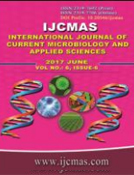


 National Academy of Agricultural Sciences (NAAS)
National Academy of Agricultural Sciences (NAAS)

|
PRINT ISSN : 2319-7692
Online ISSN : 2319-7706 Issues : 12 per year Publisher : Excellent Publishers Email : editorijcmas@gmail.com / submit@ijcmas.com Editor-in-chief: Dr.M.Prakash Index Copernicus ICV 2018: 95.39 NAAS RATING 2020: 5.38 |
Persistent heavy metal pollution poses a major threat to all life forms in the environment due to its toxic effects. These metals are very reactive at low concentrations and can accumulate in the food web, causing severe public health concerns. The use of microbial biosorbents is eco-friendly and cost effective; hence, it is an efficient alternative for the remediation of heavy metal contaminated environments. Microbes have various mechanisms of metal sequestration that hold greater metal biosorption capacities. The goal of microbial biosorption is to remove and/or recover metals and metalloids from solutions, using living or dead biomass and their components. This paper aims to biosorption of cadmium and mercury heavy metal ions by using some heavy metal ions resistance local fungal isolates with some agricultural wastes for removing it from industrial and municipal wastewater collected from some KSA localities using enrichment culture technique. Eighteen fungal isolates were identified according to key for fungal identification as the following: Acremonium sp., Alternaria alternata, Alternaria chlamydosporum, Aspergillus fumigatus, Aspergillus ochraceus, Aspergillus wentii, Cladosporium cladosporioides, Cunninghamella elegans, Curvularia lunata, Fusarium chlamydosporum, Mucor racemosus, Penicillium aurantiogriseum, Penicillium chrysogenum, Penicillium expansum, Penicillium oxalicum, Rhizopus stolonifer and Trichoderma viride. Two most potent fungal strains viz. Alternaria alternata and Penicillium aurantiogriseum were selected as the most potent fungal strains with tolerant up to 1000 ppm concentration for both HgCl2 and CdCl2 heavy metals. Optimum contact time for Alternaria alternata and Penicillium aurantiogriseum with both heavy metals under investigation (Cadmium and mercury) is five days. The optimum pH in both cases was 6. The optimum temperature was 30 °C. The growth of both fungi Alternaria alternata and Penicillium aurantiogriseum on cadmium and mercury ions decreased with increasing of ions concentrations. This indicated the potential of these identified fungi as biosorbent for removal of high concentration metals from wastewater and industrial effluents.
 |
 |
 |
 |
 |